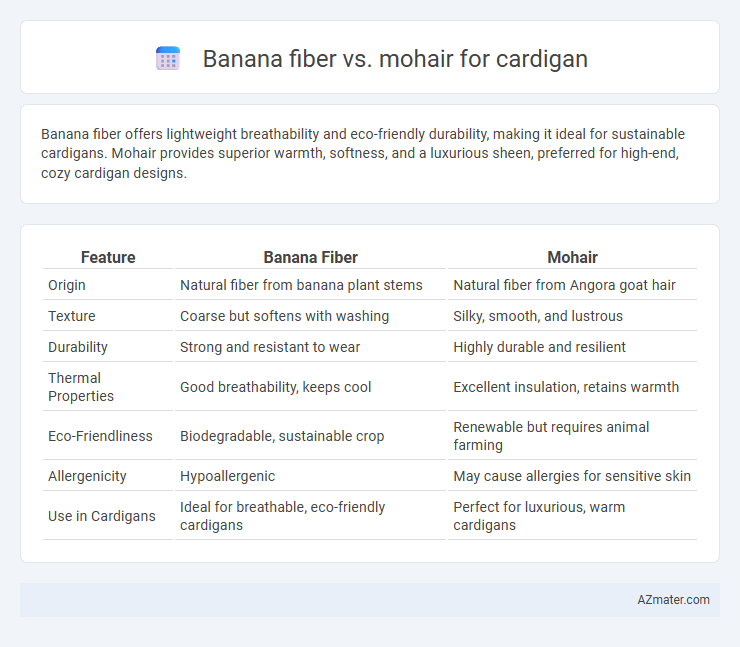Banana fiber offers lightweight breathability and eco-friendly durability, making it ideal for sustainable cardigans. Mohair provides superior warmth, softness, and a luxurious sheen, preferred for high-end, cozy cardigan designs.
Table of Comparison
| Feature | Banana Fiber | Mohair |
|---|---|---|
| Origin | Natural fiber from banana plant stems | Natural fiber from Angora goat hair |
| Texture | Coarse but softens with washing | Silky, smooth, and lustrous |
| Durability | Strong and resistant to wear | Highly durable and resilient |
| Thermal Properties | Good breathability, keeps cool | Excellent insulation, retains warmth |
| Eco-Friendliness | Biodegradable, sustainable crop | Renewable but requires animal farming |
| Allergenicity | Hypoallergenic | May cause allergies for sensitive skin |
| Use in Cardigans | Ideal for breathable, eco-friendly cardigans | Perfect for luxurious, warm cardigans |
Introduction to Banana Fiber and Mohair
Banana fiber, derived from the pseudostem of banana plants, offers a sustainable and biodegradable alternative in textile production, prized for its strength, breathability, and natural sheen. Mohair, sourced from the Angora goat, is renowned for its silky texture, excellent insulation properties, and durability, making it a luxurious choice for cardigans. Comparing banana fiber and mohair highlights differences in sustainability, texture, and warmth, influencing cardigan performance and comfort.
Origins and Production Processes
Banana fiber originates from the pseudostems of the banana plant, primarily cultivated in tropical regions like India and the Philippines, where the fibers are extracted through a labor-intensive process of stripping, washing, and drying. Mohair is derived from the Angora goat, predominantly raised in South Africa, Turkey, and the United States, with its production involving shearing the goat's coat biannually, followed by cleaning, carding, and spinning. The sustainable harvesting of banana fiber contrasts with the animal-based, renewable nature of mohair, influencing the texture and durability of cardigans crafted from each material.
Sustainability and Environmental Impact
Banana fiber, derived from agricultural waste, offers a highly sustainable alternative to mohair, which is sourced from Angora goats and raises concerns about animal welfare and land use. Banana fiber production requires less water and generates fewer greenhouse gas emissions compared to mohair, which involves intensive animal farming practices. Using banana fiber in cardigans supports eco-friendly fashion initiatives by reducing reliance on animal fibers and minimizing environmental footprints.
Texture and Comfort Comparison
Banana fiber offers a coarse yet breathable texture that becomes softer with wear, providing a natural, eco-friendly alternative for cardigan fabrics. Mohair, derived from the Angora goat, is renowned for its silky, smooth, and luxurious feel, delivering superior warmth and softness against the skin. While banana fiber excels in durability and moisture-wicking properties, mohair provides exceptional comfort and a plush texture, making both fibers unique choices depending on desired cardigan feel and performance.
Warmth and Insulation Properties
Banana fiber offers moderate warmth and breathability due to its natural cellulose structure, making it suitable for lightweight cardigans with good insulation in mild climates. Mohair, derived from Angora goats, provides superior warmth and excellent insulation through its fine, hollow fibers that trap heat efficiently, ideal for cold-weather cardigans. Compared to banana fiber, mohair's thermal regulation and moisture-wicking properties make it a preferred choice for retaining heat without sacrificing comfort in colder conditions.
Durability and Longevity
Banana fiber offers excellent durability due to its strong, natural cellulose fibers resistant to wear, making it suitable for long-lasting cardigans. Mohair, derived from the Angora goat, provides impressive longevity with its elastic and resilient strands that maintain shape and resist pilling over time. Choosing between banana fiber and mohair depends on the desired balance of natural eco-friendliness versus luxurious softness and durability in cardigan fabrics.
Care and Maintenance Requirements
Banana fiber cardigans require gentle washing in cold water to preserve their natural texture and prevent shrinkage, while mohair garments demand delicate hand washing or dry cleaning to maintain softness and avoid felting. Both materials benefit from air drying away from direct sunlight to prevent fiber damage, but mohair is particularly sensitive to heat and friction, necessitating careful storage to avoid pilling. Regular brushing with a soft garment brush helps sustain mohair's fluffy appearance, whereas banana fiber cardigans need minimal maintenance due to their inherent durability.
Allergies and Skin Sensitivities
Banana fiber is hypoallergenic and naturally breathable, making it an excellent choice for people with allergies or sensitive skin, as it resists dust mites and mold. Mohair, derived from Angora goats, can cause irritation and allergic reactions in some individuals due to lanolin and its coarse texture. Choosing banana fiber for a cardigan helps minimize skin irritation and allergic responses, whereas mohair may require caution for those prone to sensitivities.
Cost and Market Availability
Banana fiber cardigans generally cost less than mohair due to the lower production expenses and greater availability of banana plants in tropical regions. Mohair, sourced from the Angora goat, commands higher prices driven by labor-intensive shearing and limited supply, making it a premium fabric in the market. Availability of banana fiber is increasing with sustainable fashion trends, whereas mohair remains niche and less accessible outside specialty markets.
Choosing the Best Fiber for Cardigans
Banana fiber offers exceptional breathability, sustainability, and durability, making it an eco-friendly choice for cardigans designed for warm climates. Mohair provides superior softness, elasticity, and insulation, ideal for luxurious, warm cardigans suitable for cooler weather. Selecting the best fiber depends on the desired cardigan properties: breathability and eco-consciousness favor banana fiber, while warmth and softness favor mohair.

Infographic: Banana fiber vs Mohair for Cardigan
 azmater.com
azmater.com